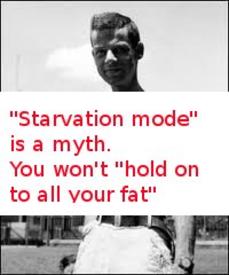Studies show it isn't calories in/ calories out

TheRealParisLove
Posts: 1,907 Member
"Many foods may be incorrectly labeled in terms of calorie value because it changes based on the way food is prepared and its freshness, and simply because of reliance on poor calculation. Almonds, for example, may comprise just over 30 percent fewer calories than the USDA had previously measured. And some evidence suggests that gut bacteria consumes some of the caloric content of our food, Mother Jones reported."
In other words, not all calories are created equal. We may need to reassess how we actually measure food and what we need for energy, giving a higher calorie count to processed foods, and reducing the calorie count in natural foods.
You can read the whole article here:
http://www.huffingtonpost.com/2013/05/22/calorie-counts-menu-label-nutrition_n_3247864.html?utm_hp_ref=healthy-living
In other words, not all calories are created equal. We may need to reassess how we actually measure food and what we need for energy, giving a higher calorie count to processed foods, and reducing the calorie count in natural foods.
You can read the whole article here:
http://www.huffingtonpost.com/2013/05/22/calorie-counts-menu-label-nutrition_n_3247864.html?utm_hp_ref=healthy-living
0
Replies
-
Interesting. Although none of this is really new information. And again, none of this is an exact science.
Bottom line is if you want to lose weight you need to eat less than you expend. How much you expend is going to vary from person to person and how many calories are in the food you eat is going to vary as well.0 -
The title of your topic is plain wrong. The study shows that counting calories isn't always accurate, but the principle of calories in/calories out still stands.0
-
^ This.The title of your topic is plain wrong. The study shows that counting calories isn't always accurate, but the principle of calories in/calories out still stands.
It still is calories in, calories out. It's just that we may sometimes put in more or less than we think...
Also, numbers may change on paper. But in real life practice it will not make enough of significant difference for it to be worth counting everything so carefully...0 -
the presence of whole peanuts in faeces points to the fact that not all of the calories in a food may be liberated in the body.0
-
This is a much better article on the subject:
http://evolvinghealthscience.blogspot.co.uk/2013/02/calories-arent-right-on-labels-and.html0 -
Interesting article and something to think about. I have always believed that everyone is different in what they absorb anyway. For instance, if you are low on Vit D, then your body does not absorb Calcium like it should, therefore, you are not getting the benefits you need.
Always good to rethink things once in a while
Thanks for sharing0 -
It's actually the inverse property of thigh gap quotient to the amount of <1200 calorie threads x multiplied by grumpy cat then taken to the nth power over broscience subtracted from real science all in proportion to sum total of "What's my TDEE" and "Smash or Pass" threads.0
-
the presence of whole peanuts in faeces points to the fact that not all of the calories in a food may be liberated in the body.
I fancy a Snickers bar now.0 -
Ugh. Huffpost.
The fact that 'numbers' don't mean anything to some people is irrelevant: neither will 'exercise equivalents' be meaningful to everyone. If people were educated about what a calorie is, how many they should be eating per day, and how many they should be burning per day, there wouldn't be a problem with using this numerical measure.
Of course, calorie counts are not accurate. The way that calories are worked out is by putting the food in a combustion chamber and measuring the energy released. Our bodies don't totally combust foods, and our bodies all work slightly differently, so it's never going to precisely comparable, BUT it does give us an idea. Exactly the same argument could be applied to 'exercise equivalents' - stating that a bag of chips will take a 3 mile run to burn off (or whatever) isn't wholly useful because it will depend how fast you run, how your body works, whether it is TOM, etc etc etc.
I can see that exercise equivalents (which in themselves are a way of quantifying 'calories out') could be useful ALONGSIDE calorie counts to help people realise what a calorie actually is and how different foods compare to others, but I don't think they should replace calorie counts because at the end of the day, it IS calories in/calories out.0 -
The title is wrong. It should be "Actually it is calories in/calories out but it's really difficult to know precisely how many calories are going in/out so your best bet is to move more and eat less which we already knew so this article isn't actually very interesting". But I must admit, yours is snappier.0
-
which is why you don't see fat squirrels...the presence of whole peanuts in faeces points to the fact that not all of the calories in a food may be liberated in the body.0 -
I just assume it all averages out. If I were that bothered, I'd switch to the TDEE method, modify the TEF multiplier from 1.1 to (perhaps) 1.09 or 1.11 (depending on amount of non-fresh food vs amount of protein and insoluble fibre (and whether it is being counted at 4 kcal/gram or 0 kcal/gram on the label)), and then recalculate my TDEE 20 times per day so the +/- 3-5 lb of intra-day weight fluctuations are also taken into account. I'm not that bothered, so average is fine for me.0
-
It's actually the inverse property of thigh gap quotient to the amount of <1200 calorie threads x multiplied by grumpy cat then taken to the nth power over broscience subtracted from real science all in proportion to sum total of "What's my TDEE" and "Smash or Pass" threads.
Oh I love you0 -
There's a fat squirrel in my garden every day.
which is why you don't see fat squirrels...the presence of whole peanuts in faeces points to the fact that not all of the calories in a food may be liberated in the body.
All this shows is that counting calories is an educated guess at best. Probably why it works best if you adjust the amount you're eating rather than trying to drastically change your diet.0 -
It's actually the inverse property of thigh gap quotient to the amount of <1200 calorie threads x multiplied by grumpy cat then taken to the nth power over broscience subtracted from real science all in proportion to sum total of "What's my TDEE" and "Smash or Pass" threads.
Oh I love you
:laugh:0 -
I've seen fat squirrels. That's all.
which is why you don't see fat squirrels...the presence of whole peanuts in faeces points to the fact that not all of the calories in a food may be liberated in the body.0 -
Since calorie count in food tends to be measured by a machine that burns them, its a bit hard to count all calories as exactly the same when our bodies operate differently to a machine
but then again some people are built like damn machines!0 -
which is why you don't see fat squirrels...the presence of whole peanuts in faeces points to the fact that not all of the calories in a food may be liberated in the body.
I've seen a fat squirrel.....:laugh:0 -
bump for later...0
-
the title of your post is misleading ...I am flagging this ..lock this down now!
JK ..
although, please endeavor to make your thread titles match topic...
certified thread title guy0 -
I've seen fat squirrels. That's all.
which is why you don't see fat squirrels...the presence of whole peanuts in faeces points to the fact that not all of the calories in a food may be liberated in the body.
So have I! On my school'd campus I have seen squirrels with whole cookies, chicken wings, etc by the south campus dining hall!0 -
oh and i skimmed the article it seems more to be concerned with that americans don't understand the caloric values that are posted on the labels...
I did not really see anything that says if you eat less calories then you take in that you will not lose weight..
so remind what the topic is again, and what the point is?0 -
BRO MATH0
-
which is why you don't see fat squirrels...the presence of whole peanuts in faeces points to the fact that not all of the calories in a food may be liberated in the body.
The fat squirrels are the ones that know enough to actually chew their food instead of swallowing whole nuts.0 -
It's actually the inverse property of thigh gap quotient to the amount of <1200 calorie threads x multiplied by grumpy cat then taken to the nth power over broscience subtracted from real science all in proportion to sum total of "What's my TDEE" and "Smash or Pass" threads.
 )
)
Made my day....0 -
The title of your topic is plain wrong. The study shows that counting calories isn't always accurate, but the principle of calories in/calories out still stands.
QFT. And I've seen this study before. People routinely miscalculate their calorie intake for a variety of reasons... even with 'natural foods'. Old news.0 -
which is why you don't see fat squirrels...the presence of whole peanuts in faeces points to the fact that not all of the calories in a food may be liberated in the body.
there are fat squirrels around McDonalds! I mean real squirrels 0
I mean real squirrels 0
This discussion has been closed.
Categories
- All Categories
- 1.4M Health, Wellness and Goals
- 398.4K Introduce Yourself
- 44.7K Getting Started
- 261K Health and Weight Loss
- 176.4K Food and Nutrition
- 47.7K Recipes
- 233K Fitness and Exercise
- 462 Sleep, Mindfulness and Overall Wellness
- 6.5K Goal: Maintaining Weight
- 8.7K Goal: Gaining Weight and Body Building
- 153.5K Motivation and Support
- 8.4K Challenges
- 1.4K Debate Club
- 96.5K Chit-Chat
- 2.6K Fun and Games
- 4.7K MyFitnessPal Information
- 17 News and Announcements
- 21 MyFitnessPal Academy
- 1.5K Feature Suggestions and Ideas
- 3.2K MyFitnessPal Tech Support Questions





















